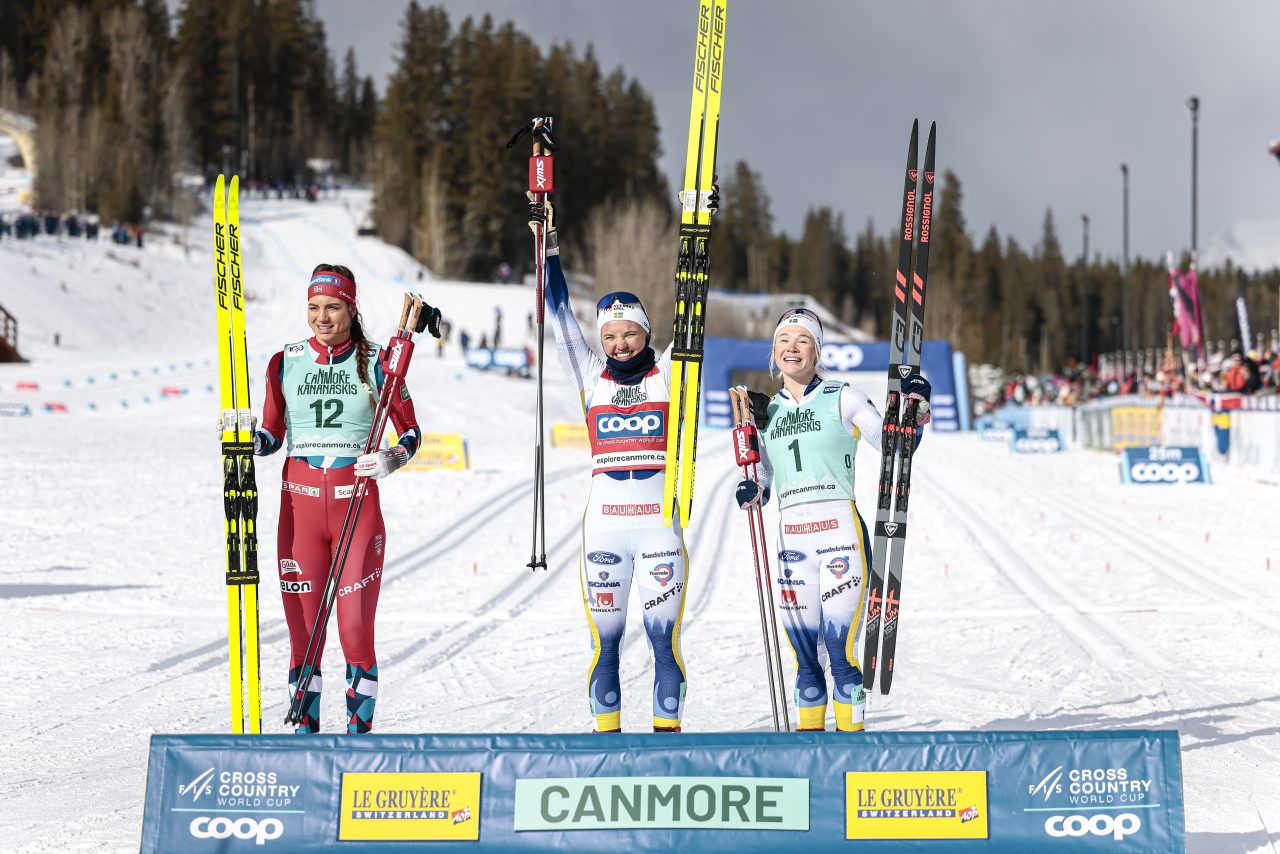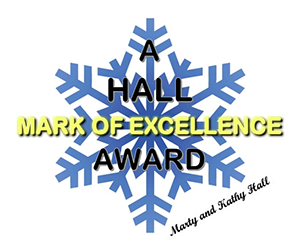 This coverage is made possible through the generous support of Marty and Kathy Hall and A Hall Mark of Excellence Award. To learn more about A Hall Mark of Excellence Award, or to learn how you can support FasterSkier’s coverage, please contact info@fasterskier.com.
This coverage is made possible through the generous support of Marty and Kathy Hall and A Hall Mark of Excellence Award. To learn more about A Hall Mark of Excellence Award, or to learn how you can support FasterSkier’s coverage, please contact info@fasterskier.com.
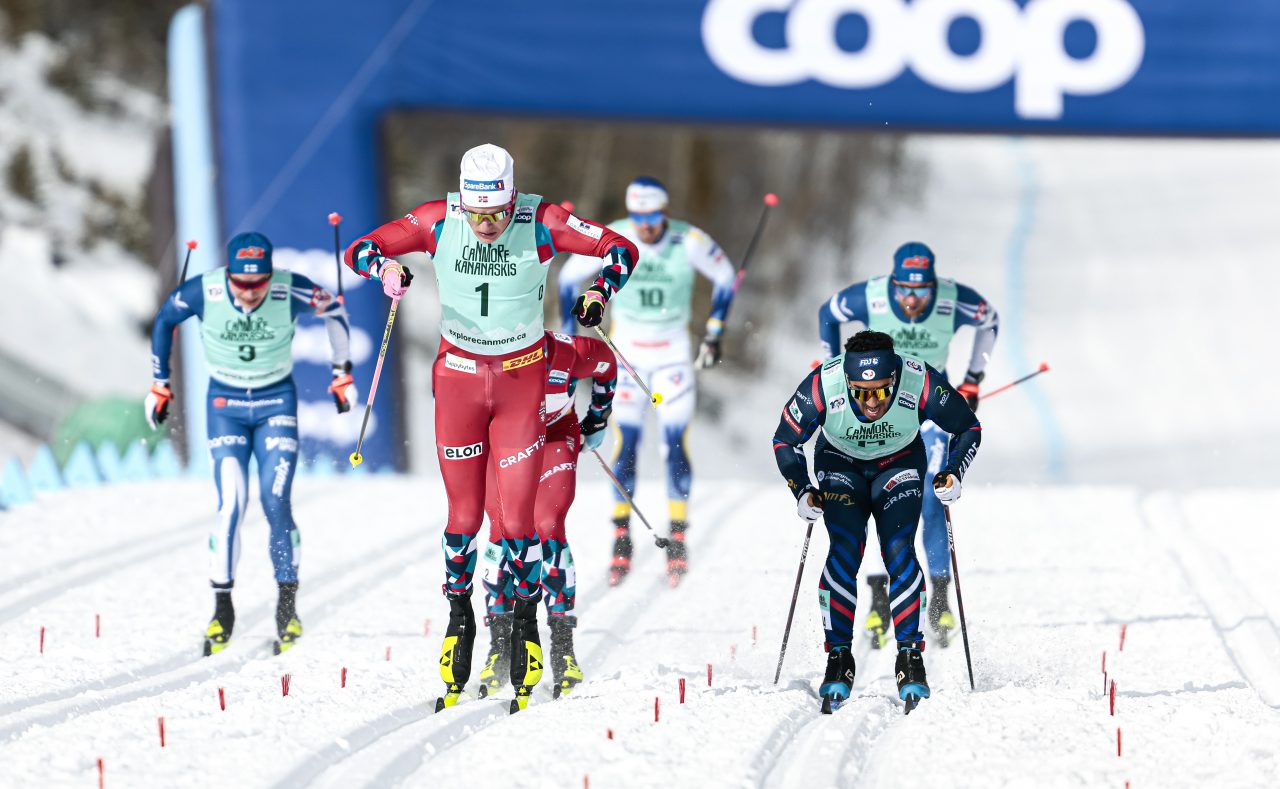
Today marked the conclusion of World Cup racing in Canmore. So far, the competition has been exciting and hard fought. The buildup to today’s races promised to mark an appropriate epilogue to the stay in Canada. On tap today were the Classic Sprints. Recent events have added some tension to today’s races for both the men and women.
On the men’s side, the competition for the Sprint championship is still up for grabs. Erik Valnes (NOR) had a scant 14 point lead over Johannes Hoesflot Klaebo (NOR). Klaebo is fighting to regain his position atop the Sprint standings as he attempts to overcome an early season deficit created by illness. Normally, anyone holding such a slim lead over Klaebo would be expected to be ground into submission; as Klaebo normally does to Sprint competitors. However, after Sunday’s 20-kilometer Classic race, new doubt has again been cast over Klaebo’s invincibility. In that race, his countryman Paal Golberg decisively outsprinted Klaebo in a double pole duel at the finish. Was this a sign of more Klaebo weakness, or simply the result of a sprint coming at the end of a 20-kilometer race? This question brought an unusual tinge of anticipation to the often predictable men’s Sprint.
Klaebo brought an early rebuke to his doubters by qualifying in first place for the heats. Valnes qualified second. By beating Valnes by one spot, Klaebo gained three points on his rival before the heats even began.
American JC Schoonmaker had an impressive performance in the qualifying round finishing fourth. He would be joined in the Sprint heats by his teammates Zak Ketterson, Luke Jager, and Gus Schumacher. Four American men into Classic Sprints could already be viewed as a successful day.
Team USA’s chances suffered a significant blow when Ben Ogden did not start after he woke up feeling poorly.
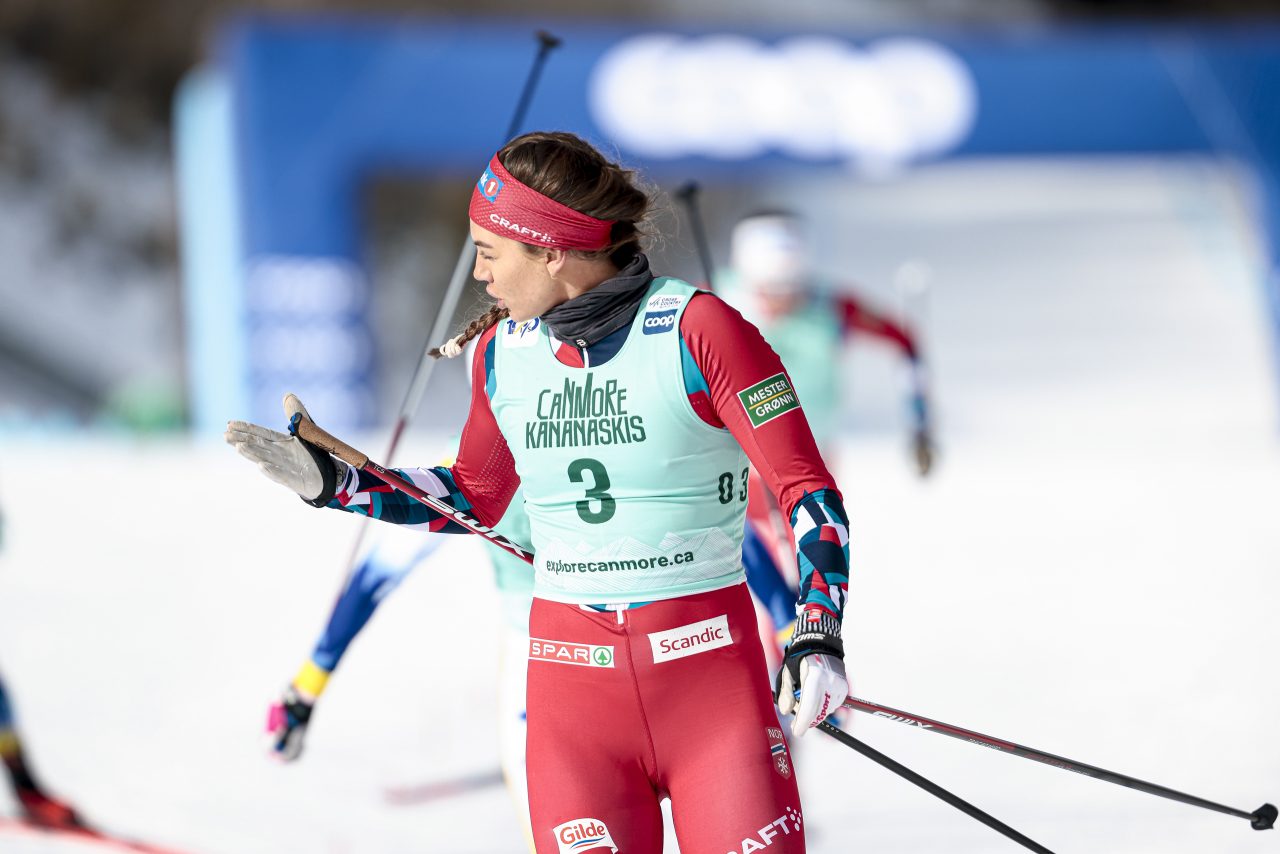
On the women’s side there has also been renewed vigor injected into the Sprint competition. The Swedish women have dominated the Sprints all season with Kristine Stavaas Skistad (NOR) being the only woman to consistently challenge the Swedes. However, taunts and social media barbs by Skistad have heightened the tension level. As she crossed the finish line first in Saturday’s Freestyle Sprint, Skistad turn and blew a mocking kiss to her Swedish counterparts.
The Swedish skiers seemed content to let their performances do their talking for them. However, much of the cross-country world doesn’t feel the same way, and is now either viewing Skistad as a spicy warrior, or a poor sporting heel, depending upon your point of view— and probably just as importantly the color of your country’s flag. Rather than focusing on the air-kiss, Norwegian media is targeting the fact that after the race Maja Dahlqvist (SWE) was fined 250 Swiss Francs (about $285 USD) for not wearing proper identification. It would seem that coming to the New World has stoked some new fire into the old European powers’ cross-country competition rivalries.
Somewhat lost in the Sprint border war was the fact that Jessie Diggins (USA) was only 25 points behind Skistad for second place in the Sprint competition. But they both trailed Linn Svahn (SWE) by a significant margin.
The American squad sent three women into the heats: Diggins, Rosie Brennan, and Julia Kern.
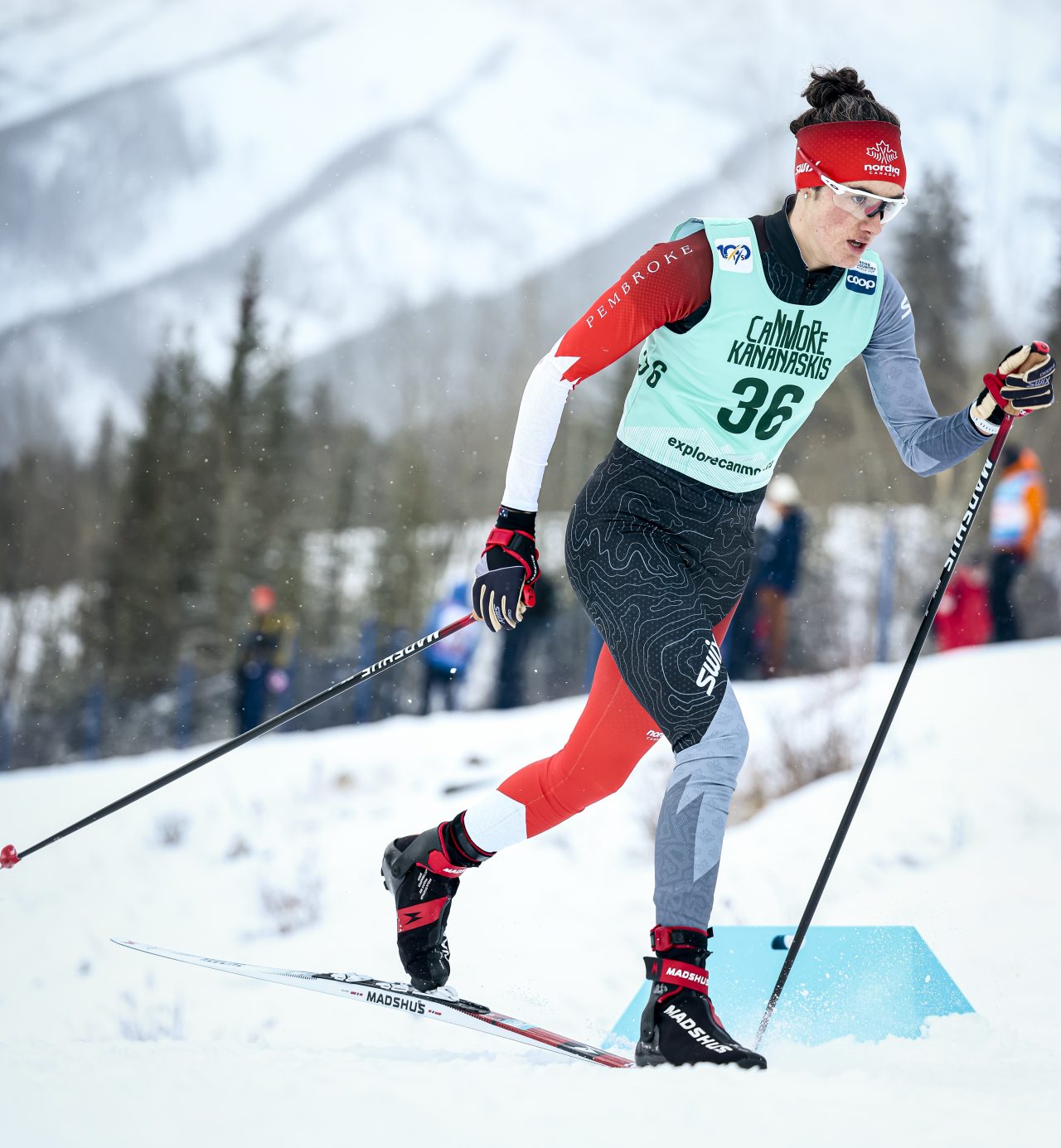
Canada’s Olivia Bouffard-Nesbitt also qualified for the Sprints, the first time she has reached the heats in a World Cup Classic Sprint. “It feels amazing,” said Bouffard-Nesbitt. “This is where you want to be. Typically, I like to plan a lot for my races, but for this heat, I had to ski intuitively. I definitely made mistakes … such as going into the far right lane, which was silly, I was totally pinched. I made the mistake which a Canadian should never make and lead into the downhill.”
In the women’s finals, Scandinavia got the matchup it was hoping for as Skistad reached the finals along with a quartet of Swedes. At the end of a furious race it was Linn Svahn (SWE) soundly defeating Skistad, who nipped Jonna Sundling (SWE) in a photo finish.
The top American finisher was Julia Kern in 11th. She was followed by Rosie Brennan 16th, Jessie Diggins 17th, Renae Anderson 36th, Erin Bianco 38th, Lauren Jortberg 43rd, Margie Freed 45th, Alexandra Lawson 46th, Alayna Sonnesyn 47th, Emma Albrecht 48th, Sydney Palmer-Leger 49th, and Michaela Keller-Miller 51st.
The top Canadian was Olivia Bouffard-Nesbitt in 30th. Other Canadian finishers were Katherine Weaver 31st, Katherine Stewart Jones 42nd, Anna Parent 44th, Anna Stewart 50th, Elie-Anne Tremblay 52nd, and Maeve Macleod 53rd.
In the men’s competition, questions about Klaebo’s status were somewhat answered as he took the victory. Richard Jouve (FRA) finished second and Valnes was third. Klaebo’s performance was enough to make the men’s Sprint competition as tight as it could be. After the race, Valnes led by only one point.
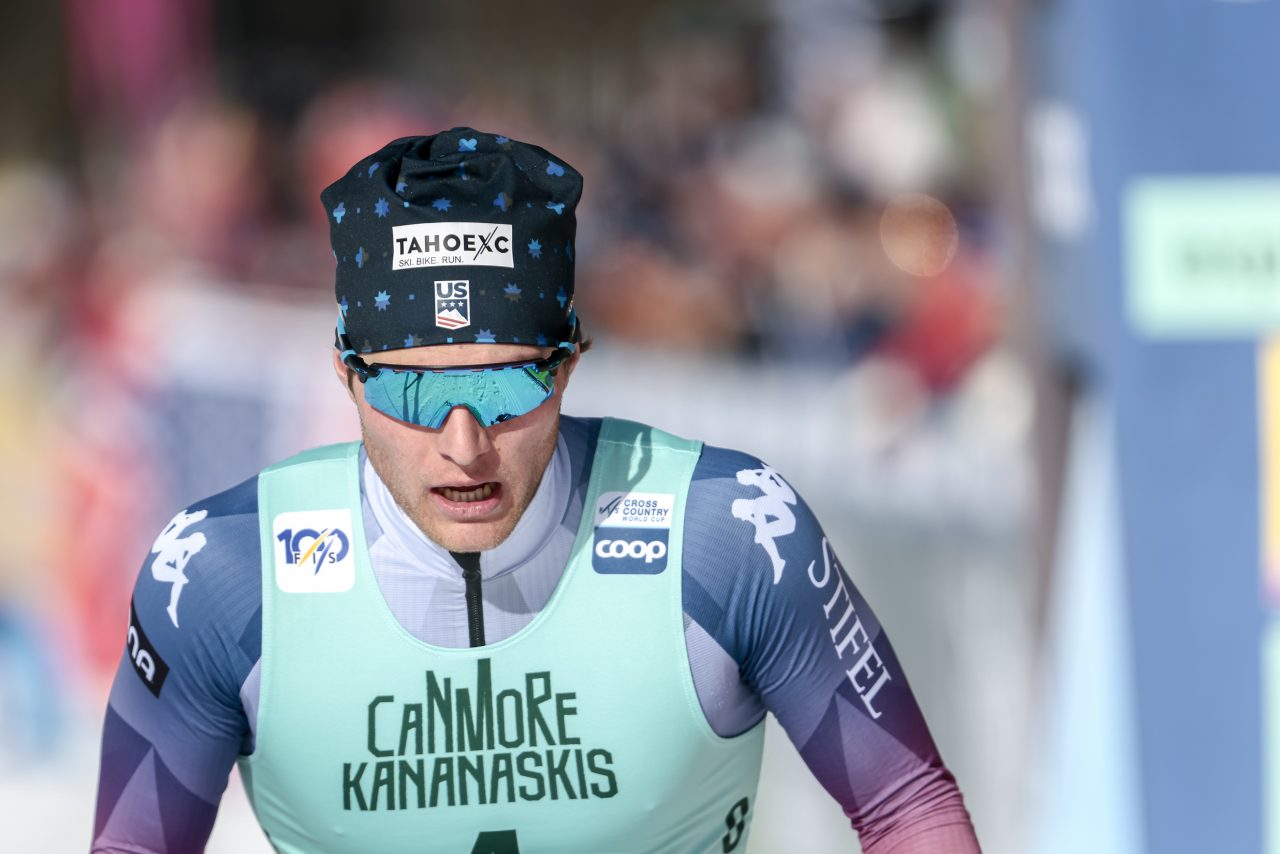
The top American was JC Schoonmaker in 7th. He was followed by Zak Ketterson 18th, Gus Schumacher 20th, Luke Jager 24th, Zanden McMullen 33rd, Kevin Bolger 35th, Michael Earnhart 42nd, Murphy Kimball 49th, Will Koch 50th, Logan Diekmann 52nd, Jack Young 56th, and Graham Houtsma 58th.
The top Canadian man was Xavier McKeever in 19th. He was followed by Antoine Cyr 28th, Pierre Grall-Johnson 29th, Julian Smith 37th, Olivier Leveille 43rd, Ry Prior 47th, Julien Locke 53rd, Leo Grandbois 54th, Felix-Olivier Moreau 59th, Erikson Moore 60th, and Xavier Lefebvre 61st,
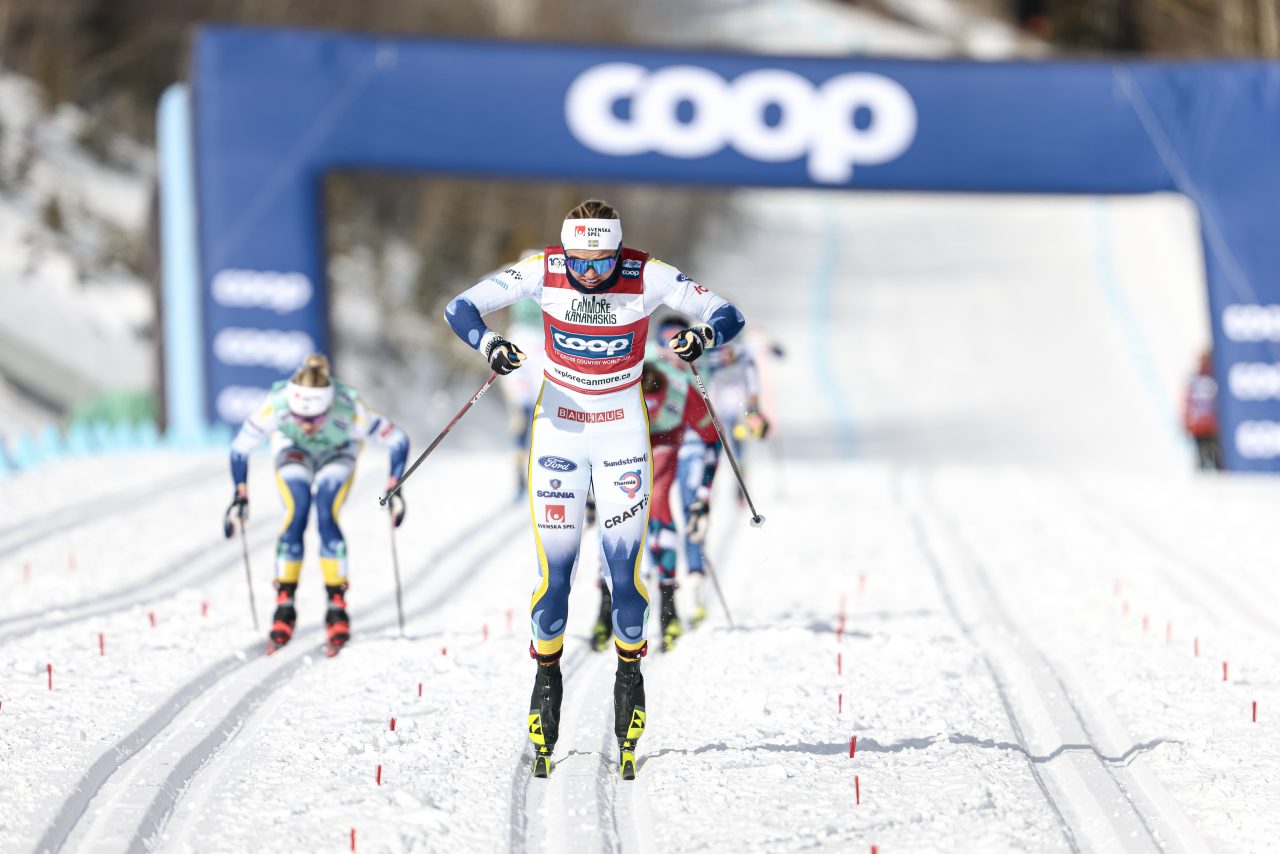
Women’s Classic Sprints
The first quarterfinal saw the matchup which many fans were looking forward to as Skistad went up against one of her Swedish rivals, Jonna Sundling. Sundling jumped to an early lead and quickly separated herself from the pack by a substantial amount, while Skistad held back. Sundling was trying to rule out a double pole duel at the finish with Skistad, which is exactly what she did, as Skistad held back and played it coyly, conserving energy for later races and finished second.
Two more Swedes—Linn Svahn, the Sprint leader and Frida Karlsson—were in the second quarterfinal. Karlsson has found sudden Sprinting success this season. But Karlsson faded in the long finishing double pole sprint while Svahn and Victoria Carl (GER) surged to advance.
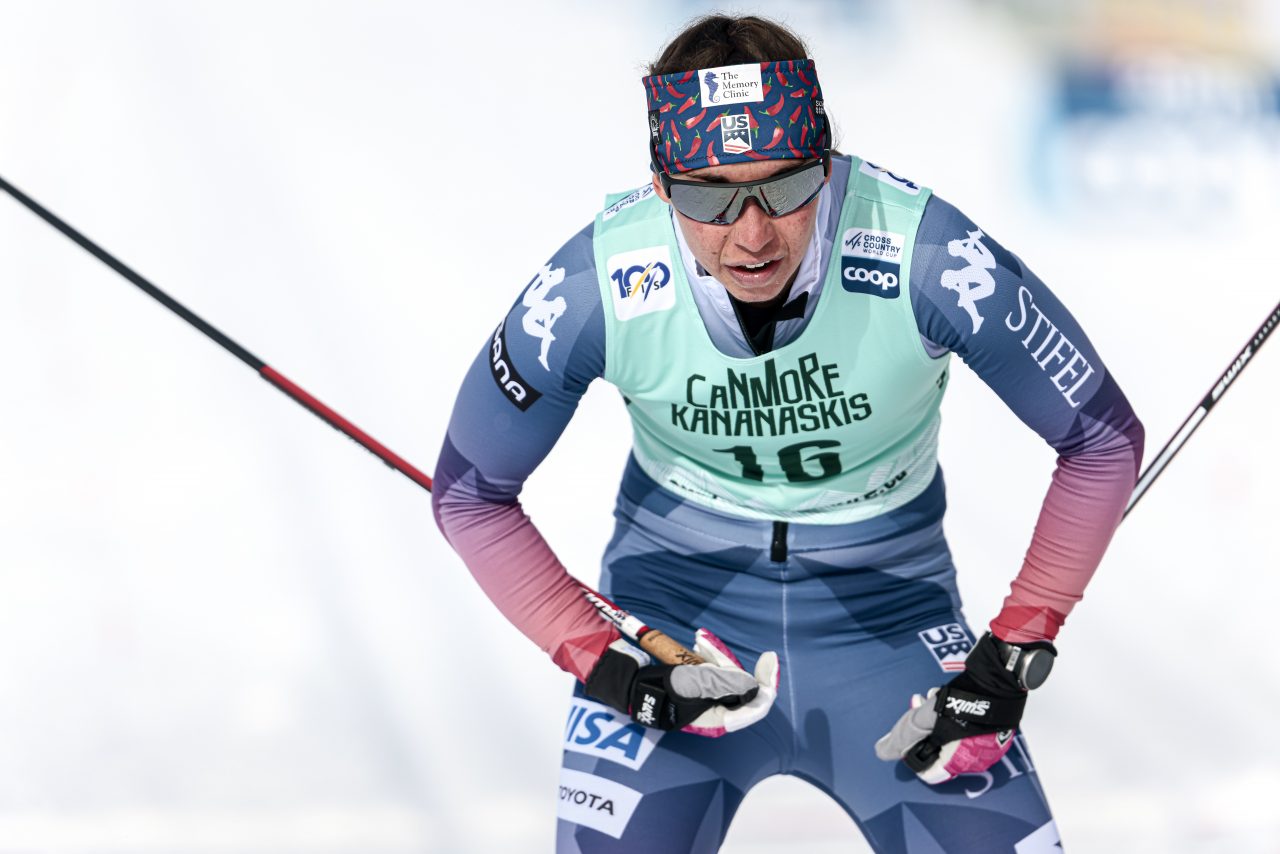
Brennan and Kern were in the third quarterfinal. They were both pushed to the rear of the pack early on. In the long double pole sprint to the finish Kerttu Niskanen (FIN) took the win and Nadine Faehndrich (SUI) finished second. Julia Kern finished third and would have to wait on a lucky loser position. Brennan’s day would be done. After the race Brennan was asked how she was doing. “I’m fine,” she said, then added, “I’m not very happy with how it ended up. I didn’t have a good enough finish and that sucks. It came down to a sprint finish and I didn’t have it.” Brennan observed that the snow was, “very tricky. There are slow spots and fast spots and that makes it challenging.”
In the fourth heat the entire pack of six racers entered the stadium together setting up a six-way double pole shootout. It was two Swedes, Dahlqvist (SWE) and Emma Ribom (SWE) who would advance.
Diggins was in the fifth heat where she would face Johanna Hagstroem (SWE) and Heidi Weng (NOR). Diggins quickly did what she has been doing throughout the Sprint season and quickly went to the front and was followed by Laura Gimmler (GER) and Hagstroem. The three skiers formed a breakaway group and entered the stadium together with Diggins out front. Another long double pole fight ensued with Gimmler and Hagstroem outpacing Diggins who finished fourth. Diggins day was over, while Weng would advance as a lucky loser. The outcome meant that Kern would advance as a lucky loser.
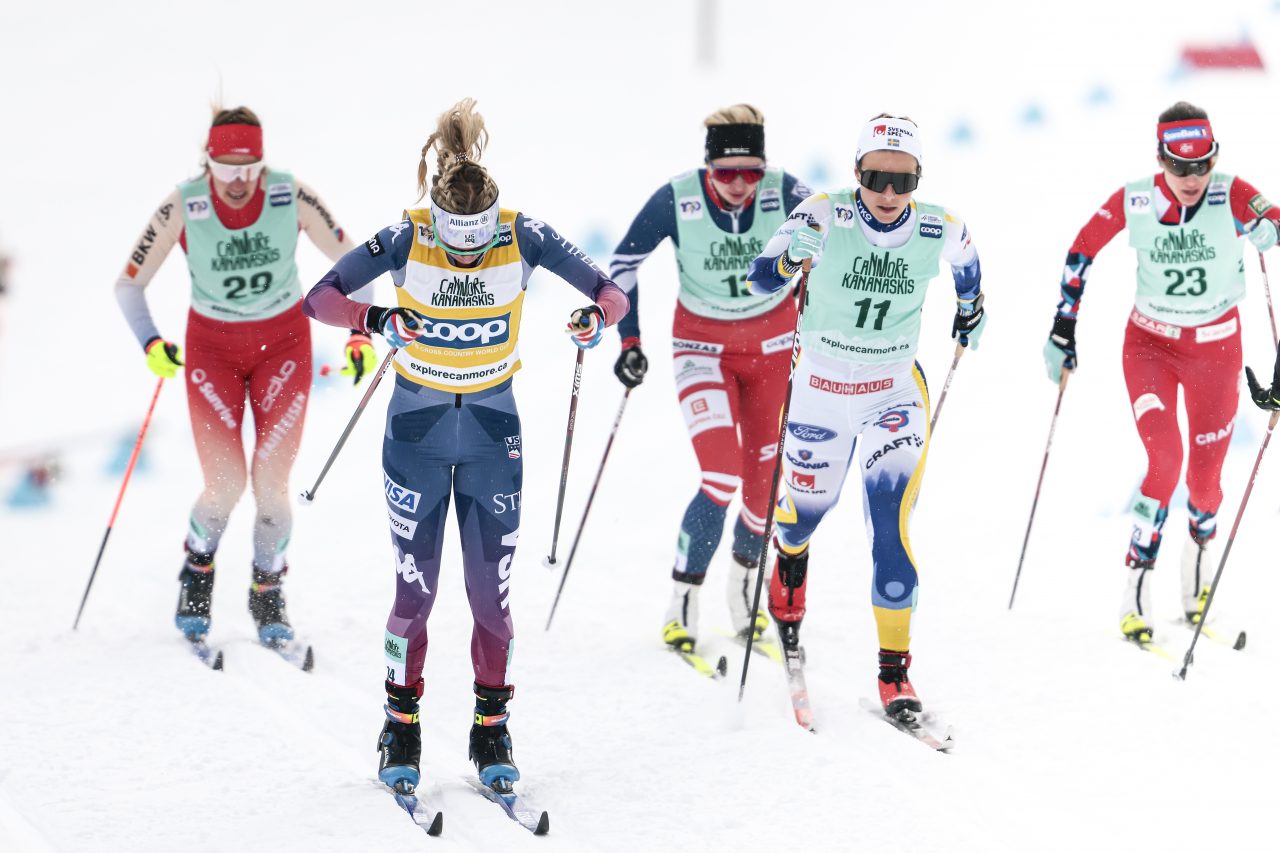
With an early departure Diggins had some extra time to chat with the media. After the race Diggins was asked about the constant post-race camera presence on her, especially after she collapses. “I’m unaware of its [the camera’s] presence until afterwards,” she said. “You’re most vulnerable self is being followed all the time. We’re obviously outdoors, so you have no privacy. On the one hand that’s cool…but at the same time when you need a second, you don’t have it . . . I have had to adjust to and get used to over the years because when you grow up as a cross-country skier in the U.S. you don’t expect to be in tabloids, or that part of my career path will involve people wanting my time and attention. It’s been something where I have to not be overwhelmed by it. I hope I’m doing an ok job. If I don’t interact with everyone it’s not because I don’t want to, it’s because I can’t.”
Women’s Semifinals
The first semifinal featured the only American to advance; Julia Kern. Skistad Svahn and Sundling were also in the heat. Skistad employed a different tactic and immediately went to the front with Sundling. She was not able to maintain that pace and was quickly eclipsed by Sundling and Svahn. Sundling put the pressure on from the front to try and put enough of a gap on Skistad to take away the draft advantage of the last hill. But Skistad was able to close the gap as they entered the stadium and put in a strong double pole effort to hold off Sundling. Svahn finished first. Kern finished sixth.
The second semifinal was a very slow pace as racers jockeyed for position. No one wanted to lead into the final downhill, but someone had to, and it was Emma Ribom (SWE) who managed to hang on to the victory. Dahlqvist held on for second.
The final set up for the match most European fans wanted; four Swedes versus Skistad.

Women’s Finals
The women’s finals consisted of Svahn, Ribom, Skistad, Dahlqvist, Sundling and Kerttu Niskanen (FIN). With the very long flat finishing stretch Sweden’s best hope in the final would be to go out fast and try to take the legs, and arms, out of Skistad. But Skistad was wise to the strategy and shot out from the start claiming the lead for herself, then was joined by Sundling and Svahn. Sundling pushed hard knowing that if she didn’t have a big gap over Skistad that she wouldn’t be able to keep up at the finish. But Skistad was able to catch the Swedes on the final downhill. Then Svahn put in a furiously powerful double pole stretch and pulled away from the field. Skistad out-lunged Sundling at the line in a photo-finish as she collapsed at the finish. No kisses were exchanged, but Sundling and Svahn came over to congratulate Skistad as she lay on the ground.
After the race Svahn acknowledged that Sweden’s strategy was to go fast the entire way and she was clearly happy with her win. She seemed pleased with winning another Canmore cowboy hat. “I think I will be happier with this one,” she said, a playful reference to earlier the race where she had finished second.
Men’s Classic Sprints
Klaebo and Valnes were both in the first quarterfinal along with Schumacher, who hung with the leaders through most of the race. Klaebo led a double pole sprint to the finish line where Valnes accompanied him to advance. Schumacher finished fourth, which meant he could still move on if he could hold out for a lucky loser.
The second heat had two Americans, JC Schoonmaker and Luke Jager. They were joined by another North American, Antoine Cyr (CAN). The hometown crowd inspired Cyr as he went to the front to try and gap the field. It was a risky move for Cyr since being in the lead has not worked well for most men on this course. On the downhill going into the finish, Cyr was passed by the field. Richard Jouve (FRA) and Even Northug (NOR) finished 1-2 with Schoonmaker third. He would now wait for a lucky loser spot after he had displaced his teammate Schumacher from lucky loser contention.
No Americans were in the third heat, but two Canadians Pierre Grall-Johnson and 19 year old Xavier McKeever would take their shot. In a very tactical race, the Canadians could not overcome Mattis Stenshagen (NOR) and Lucas Chanavat (FRA) who finished first and second.
In the fourth heat Calle Halfvarsson (SWE) and Lauri Vuorinen (FIN) took advantage of the large downhill leading into the stadium and skied a perfect tactical race to advance.
Zak Ketterson (USA) was in the final heat. It would be a difficult challenge for Ketterson who was the slowest qualifier in this heat. Joni Maki (FIN) went out hard and tried to get a large enough lead to avoid being swallowed up by the draft on the final hill. His strategy worked as he crossed the finish line with his teammate Niilo Moilanen. Ketterson finished fourth and would not advance.
Ketterson’s disappointment was Schoonmaker’s gain as he held on the advance as a lucky loser. He would be the only American man to advance.
Men’s Semifinals
Klaebo and Valnes were again paired together, this time in the semifinal. The duo set the tempo with Jouve tucking in behind them. In a fiercely contested finish Klaebo took the win with Jouve coming in second. Valnes would advance on a lucky loser position. Klaebo did not let up as he often does at the finish and looked like he had a message to send.
JC Schoonmaker was in the second semifinal. Schoonmaker was quickly moved to the back of the field as Moilanen set a brisk pace at the front. In the final push Schoonmaker came from way back to finish fourth, but it wasn’t good enough for a lucky loser position. Vuorinen and Joni Maki (FIN) took the top spots.
Men’s Finals
In the finals it was Klaebo and Valnes going in as the favorites up against Jouve, Vuorinen, Maki and Calle Halfvarsson (SWE). Klaebo and Vuorinen went to the front with Klaebo pushing the pace. It looked like his strategy was to push the field the entire way and negate the finishing draft. But the field was able to hang with him and he had to let up as the pack was able to hang with him. The pace relaxed as the skiers positioned themselves coming into the final downhill. Klaebo went to the front again with Jouve keeping pace with him. But no one could match Klaebo’s double poling as Jouve finished second. Valnes finished third. While it wasn’t an easy victory for Klaebo, it did answer some of the questions about whether he was back.
“After I saw Jouve’s skis on his side, I thought oh no, not again,” Klaebo said. “[I tried] to be in the front and push hard but missed on a pole plant and just tried to go forward.”
It was a long and exciting day of Sprinting to conclude the World Cup in Canmore. Next stop; Minneapolis.

